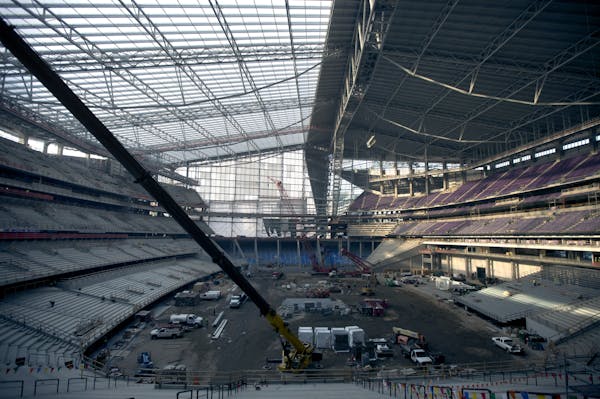As U.S. District Court Judge Donovan Frank heard arguments on the signs dispute between the Vikings and Wells Fargo, he repeated a question several times: Why couldn't everyone sit down and work it out when so much is at stake?
The Vikings have asked Frank to issue an emergency order to force Wells Fargo to cover signs on the rooftops of their two 17-story buildings adjacent to the new U.S. Bank Stadium in downtown Minneapolis. Lawyer Kevin Coan argued that the signs amount to the sort of "ambush advertising" the Vikings wanted to prevent around the new stadium.
The team filed a lawsuit last month saying that the signs violate a two-year-old agreement because they are raised 18 inches rather than flush with the rooftops. The bank countered that the signs are within the parameters of the agreement and cause no monetary harm to the Vikings or the image of the new stadium.
Frank told the lawyers he would issue his order no later than two weeks from Friday. But he also said he would welcome all parties to a mediation session that would include the city of Minneapolis and the Minnesota Sports Facilities Authority.
"It's difficult for me to understand … why we couldn't bring everybody together," Frank said. "I would have thought the city would have stepped in and got everyone together."
Coan said the agreement from February 2014 was the coming-together of the parties.
The judge said several times that the court would volunteer to mediate the discussion and give it priority. Neither side expressed interest in that.
While the dispute is about the height of the signs, it's also about millions of dollars paid by U.S. Bank to the Vikings to emblazon their logo across the rooftop and building.
Coan said monetary damages would not be enough to compensate the harm because the Vikings had a right to control the image of the area surrounding the stadium.
The Vikings negotiated the sign agreement with Ryan Companies, the developer of the project, which includes a $300 million investment from Wells Fargo. The Vikings' authority to negotiate and control the area surrounding the stadium flowed from the initial stadium legislation.
"We're not asking for much; we're asking for them to stop violating the agreement," Coan said.
Wells Fargo lawyer Chris Grote said the signs on the rooftops are no more prominent than the flat Wells Fargo logo painted on the rooftops.
The difference between flat signs and letters raised 18 inches on 17-story buildings is minimal, Grote argued, so judicial intervention is "not appropriate when there is no irreparable harm."
Using pictures, he showed the buildings, which also have the Wells Fargo name illuminated near the top of the sides of the buildings. Then he showed aerial NBC-TV footage taken recently to demonstrate that the Wells Fargo signs are barely visible next to the stadium and therefore, he argued, not damaging to the image of the $1.1 billion stadium.
"It's a never-before-heard argument of distraction," Grote said of the Vikings' claim.
Rochelle Olson • 612-673-1747 Twitter: @rochelleolson

Former Gov. Jesse Ventura boasts he could beat unpopular Trump or Biden if he ran for president

Dave Kleis says he won't run for sixth term as St. Cloud mayor
Newspaper boxes repurposed as 'Save a Life' naloxone dispensaries

St. Cloud house vies for Ugliest House in America

